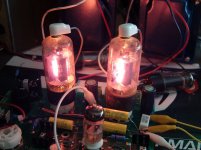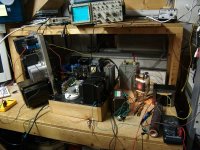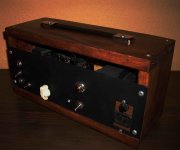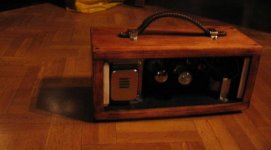Chris A says: "...Remember that tubes cool by radiation. For that to work the tube needs to "see" a clear path into the rest of the room..."
That seems way too broad a statement, but something to think about. Yes, the internal parts are cooled by black-body IR radiation, at least thru the vaccum and to the envelope. And yes typical SCHOTT AR envelope glass untreated passes a lot of IR. But this is not quartz glass. A lot of the radiated energy changes to lower-frequency heat at the envelope and a lot is carried away from the envelope by convection, and some radiation and some re-radiation or the convection removal of heat generated when the IR strikes the box enclosure etc. It sure seems they are cooled MOSTLY by convection just because it works so much better than radiation. The preamp tubes don't produce much heat, but they obviously don't just radiate infra-red shining directly from the anode and its various internal radiators thru the glass and shine thru the solid metal Faraday shields into the room. No, the vast majority of tube TVs and radios did not have any direct line of sight from the tubes to the room, and relied solely on convection, and you could feel the heat pouring out the TOP, not radiating out the sides. Even with the chassis out in open space I can feel the heat rising from the top of the amp, yet I feel less horizontal radiation at shorter distances. A lot of heat is re-radiated or removed via convection from the top of the tubes, which are usually shiny like a mirror (is that part of hte getter coating?) probably blocking direct IR radiation thru the top. If the glass passed most of the heat as IR shining thru the glass, the envelopes in a non-fan amp would be cool to the touch...but they aren't. There are plenty of fan-cooled amps with the tubes completely enclosed and if it was mostly IR the housing would get hot and the tubes would be cool; but when the envelope is kept cool by convection there seems to be little radiation; the tube cage doesn't seem to get hot. It seems to me more like the envelope re-radiates and has significant convection-cooling. If you can cool the glass envelope with a fan there's very little direct radiation. I'd imagine much of even the radiation is re-radiation from the hot glass, not transmission of the radiation from the internal parts thru cool glass. Still, I'm going to consider that direct radiation...and perhaps letting my tubes have direct sight into the room. I'm just happy I don't have to listen to a fan if I do this right. I think seeing the red glow of the heaters makes us think it's got a lot of IR shining like light, but that heater IR is only a very small part of the heat compared to the plate under high voltage and current. And without real data, maybe I'm making too strong an opposing statement. I note the Peavey c50 does have the tubes in a cage to protect the rest of the amp from directly radiated heat.
That seems way too broad a statement, but something to think about. Yes, the internal parts are cooled by black-body IR radiation, at least thru the vaccum and to the envelope. And yes typical SCHOTT AR envelope glass untreated passes a lot of IR. But this is not quartz glass. A lot of the radiated energy changes to lower-frequency heat at the envelope and a lot is carried away from the envelope by convection, and some radiation and some re-radiation or the convection removal of heat generated when the IR strikes the box enclosure etc. It sure seems they are cooled MOSTLY by convection just because it works so much better than radiation. The preamp tubes don't produce much heat, but they obviously don't just radiate infra-red shining directly from the anode and its various internal radiators thru the glass and shine thru the solid metal Faraday shields into the room. No, the vast majority of tube TVs and radios did not have any direct line of sight from the tubes to the room, and relied solely on convection, and you could feel the heat pouring out the TOP, not radiating out the sides. Even with the chassis out in open space I can feel the heat rising from the top of the amp, yet I feel less horizontal radiation at shorter distances. A lot of heat is re-radiated or removed via convection from the top of the tubes, which are usually shiny like a mirror (is that part of hte getter coating?) probably blocking direct IR radiation thru the top. If the glass passed most of the heat as IR shining thru the glass, the envelopes in a non-fan amp would be cool to the touch...but they aren't. There are plenty of fan-cooled amps with the tubes completely enclosed and if it was mostly IR the housing would get hot and the tubes would be cool; but when the envelope is kept cool by convection there seems to be little radiation; the tube cage doesn't seem to get hot. It seems to me more like the envelope re-radiates and has significant convection-cooling. If you can cool the glass envelope with a fan there's very little direct radiation. I'd imagine much of even the radiation is re-radiation from the hot glass, not transmission of the radiation from the internal parts thru cool glass. Still, I'm going to consider that direct radiation...and perhaps letting my tubes have direct sight into the room. I'm just happy I don't have to listen to a fan if I do this right. I think seeing the red glow of the heaters makes us think it's got a lot of IR shining like light, but that heater IR is only a very small part of the heat compared to the plate under high voltage and current. And without real data, maybe I'm making too strong an opposing statement. I note the Peavey c50 does have the tubes in a cage to protect the rest of the amp from directly radiated heat.
Last edited:
There is plenty of radiated IR from a power vacuum tube. There is also plenty of conducted heat that can be removed by convection. Convection will also help remove reabsorbed IR. Plenty of that inside the box too.
The direct IR radiation can be felt in some of my experiments. It can also be reflected with shiney aluminum foil.
I could obviously feel the IR in both of these rather extreme experiments. Look at the reflection in the OPT's. That's why they get warm:
The direct IR radiation can be felt in some of my experiments. It can also be reflected with shiney aluminum foil.
I could obviously feel the IR in both of these rather extreme experiments. Look at the reflection in the OPT's. That's why they get warm:
Attachments
Well, I haven't read the whole thread but......you can see the 6V6 almost touching the wood there in that picture. The wood gets warm but that 'Champ' has several years, same tube, no problems. Still, the second time around I placed the tubes in an horizontal position. You have to take care doing that with the 5Y3. The datasheet tells you how to do it, I don't remember it now.
Attachments
Actually I appreciate the idea of taking advantage of any direct radiation out of the cabinet. I'm gooing to make use of that. Conducted heat????? Where, out the pins to the socket and wires?There is also plenty of conducted heat
Chris A says: "...Remember that tubes cool by radiation. For that to work the tube needs to "see" a clear path into the rest of the room..."
That seems way too broad a statement, but something to think about. Yes, the internal parts are cooled by black-body IR radiation, at least thru the vaccum and to the envelope. And yes typical SCHOTT AR envelope glass untreated passes a lot of IR. But this is not quartz glass. A lot of the radiated energy changes to lower-frequency heat at the envelope and a lot is carried away from the envelope by convection...
Convection does cary away the heat from the OTHER stuff the tube itself heats by radiation.
An interesting experiment you can do (but don't) is to turn the power tube base up and submerge the glass envelope in a large container of room temperature water. The envelope will remain cool but the tube internals will not be effected at all. Even if you hold the tube's glass parts to a low temp. the insides do not seem to notice or care. In other words you can't get more power from a tube using water cooling. I think what this tells us is that the energy goes right through the glass and heats the inside of the cabinet or whatever is in the line of sight.
You are right, in the normal case the envelope do cool by convection but ERY little of the total energy is going into the envelope, most pass right on through.
Power Plug - 6/12 Attenuator - YouTube
I wanna build something like this, I love that wood look man, old school/retro man just killer lol.
I wanna build something like this, I love that wood look man, old school/retro man just killer lol.
Water-cooling certainly works for transmitting tubes if there's a significant heat-conducting extension of the plate thru the envelope.
From Wikipedia's page on "vaccum tube", definitely not the best technical reference:
"The method of anode cooling is dependent on the construction of the tube itself. Tubes used in consumer equipment have internal anodes, so cooling occurs through black body radiation from the anode (plate) to the glass envelope;[24] natural convection (air circulation) then removes the heat from the envelope. Tube shields that aided heat dispersal can be retrofitted on certain types of tube; they improve heat conduction from the surface of the tube to the shield itself by means of tens of copper tongues in contact with the glass tube, and have an opaque, black outside finish for improved heat radiation. The ability to remove heat may be further increased by forced-air cooling, and adding an external heat sink attached to the anode through the tube's enclosure. These measures are both implemented in the 4-1000A transmitting tube, whose anode was designed to operate while red hot, dissipating up to one kilowatt.[25]
The amount of heat that may be removed from a tube with an internal anode is limited.[24] Tubes with external anodes may be cooled using forced air, water, vapor, and multiphase. The 3CX10,000A7 is an example of a tube with an external anode cooled by forced air. Water, vapor, and multiphase cooling techniques all depend on the high specific heat and latent heat of water. The water-cooled 80 kg, 1.25 MW 8974 is among the largest commercial tubes available today.
In a water-cooled tube, the anode voltage appears directly on the cooling water surface, thus requiring the water to be an electrical insulator to prevent high voltage leakage through the cooling water to the radiator system. Water as usually supplied has ions which conduct electricity; deionized water, a good insulator, is required. Such systems usually have a built-in water-conductance monitor which will shut down the high-tension supply (often tens of kilovolts) if the conductance {measured in Mhos} becomes too high."
From Wikipedia's page on "vaccum tube", definitely not the best technical reference:
"The method of anode cooling is dependent on the construction of the tube itself. Tubes used in consumer equipment have internal anodes, so cooling occurs through black body radiation from the anode (plate) to the glass envelope;[24] natural convection (air circulation) then removes the heat from the envelope. Tube shields that aided heat dispersal can be retrofitted on certain types of tube; they improve heat conduction from the surface of the tube to the shield itself by means of tens of copper tongues in contact with the glass tube, and have an opaque, black outside finish for improved heat radiation. The ability to remove heat may be further increased by forced-air cooling, and adding an external heat sink attached to the anode through the tube's enclosure. These measures are both implemented in the 4-1000A transmitting tube, whose anode was designed to operate while red hot, dissipating up to one kilowatt.[25]
The amount of heat that may be removed from a tube with an internal anode is limited.[24] Tubes with external anodes may be cooled using forced air, water, vapor, and multiphase. The 3CX10,000A7 is an example of a tube with an external anode cooled by forced air. Water, vapor, and multiphase cooling techniques all depend on the high specific heat and latent heat of water. The water-cooled 80 kg, 1.25 MW 8974 is among the largest commercial tubes available today.
In a water-cooled tube, the anode voltage appears directly on the cooling water surface, thus requiring the water to be an electrical insulator to prevent high voltage leakage through the cooling water to the radiator system. Water as usually supplied has ions which conduct electricity; deionized water, a good insulator, is required. Such systems usually have a built-in water-conductance monitor which will shut down the high-tension supply (often tens of kilovolts) if the conductance {measured in Mhos} becomes too high."
I think what this tells us is that the energy goes right through the glass and heats the inside of the cabinet or whatever is in the line of sight.
That may be true, but your experiment only shows that the black-body radiation thru the vacuum is the limiting factor in the design, not whether subsequently outside the envelope convection or conduction predominates.
So...in a normal Fender-type head cabinet with the chassis hanging upside-down, where only a small part of the output tubes have any direct radiation 'view' of the room, what color should I paint the inside of the cabinet? Is it better to make it all reflective with white or silver paint? Or is it better to paint it black so the IR turns into heat subsequently removed by convection?
That may be true, but your experiment only shows that the black-body radiation thru the vacuum is the limiting factor in the design, not whether subsequently outside the envelope convection or conduction predominates.
My point was you CAN'T cool the tube. Even if you place in under water. So you do what you like to cool the cabinet and other parts but all that has zero effect on the tubes. Maybe the tolled or the paint will last longer. The filter caps might last longer. But you can't cool the tubes with a fan or vents. OK you can cool the glass envelopes but this does nothing but make the glass cooler. Glass works just fine when hot.
But you can't cool the tubes with a fan or vents.
I offer this experiment to the contrary. Light up a tube so that there is visible red glow on the plate. Fire up the biggest fan you can find and point it right at the hot spot on the plate. The glow will diminish slightly. The effect is subtle and best observed when the dissipation is increased until the plate barely shows glow. A fan can reduce the glow to below visibility.
We have a Flir thermal camera at work. Some day I want to do some testing on some of the metal tube coolers on the market.
Conducted heat????? Where, out the pins to the socket and wires?
Depending on the internal construction, some older tubes have a glass stem with wires protruding up into the active area. Look at some old 6SN7's. The thick glass will conduct some heat down into the base. Look at some old brown base Tung Sol 5881's. The tan base has turned rather brown from conducted heat, even in well ventillated amps with the tubes mounted right side up.
I offer this experiment to the contrary. Light up a tube so that there is visible red glow on the plate. Fire up the biggest fan you can find and point it right at the hot spot on the plate. The glow will diminish slightly. The effect is subtle and best observed when the dissipation is increased until the plate barely shows glow. A fan can reduce the glow to below visibility.
Pretty obvious, fans and ventilation have always improved temperatures in valves - it can only help.
While it's pretty well true the filaments are only cooled by radiation, the glass is cooled by conduction and convection as well, and keeping the glass cooler will reduce the filament temperatures as well.
ChrisA, Do you mean can't cool it beyond some limit?
It only indicates that the radiation thru the vacuum is the limiting factor so you can't do much to reduce the internal temp further. It doesn't prove you can't cool the tube, it proves there is a limit to how much you can cool the internals. Which is an intentional part a stable design. It says nothing at all about the frequency of the energy outside the envelope and whether radiation or convection or conduction predominates. Can't cool the tube?? No, it proves the opposite, that radiation and conduction and convection DID cool the tube sufficently. I guess you must mean that you can't cool its internals colder than necessary or something like that???? Wouldn't want that, wouldn't want to make the cathode stop emitting. And no, the glass does not work just fine when hot; when the glass is really hot it radiates back into the tube just as much as it radiates out, so convection/conduction is a better way to cool the envelope in that respect, and an abused tube will melt the glass.
But the discussion was about the ratio of radaition thru the glass versus conduction and convection cooling the glass itself. Your water experiment is about what happens inside the glass envelope and how that limits the cooling, and that's interesting but a different discussion. We all agree that inside the envelope it's all radiation, because there's no convection and only a teensie bit of conduction down the pins and supports to the glass and socket.
You're probably right that most of the energy is radiated right thru the glass, but the water experiment says nothing about that.
And of course this discussion is way too broad, as the particular tube is very relevant. Remember that most military models of power tubes don't even have glass envelopes, and the solid metal obviously doesn't allow radiation thru.
It only indicates that the radiation thru the vacuum is the limiting factor so you can't do much to reduce the internal temp further. It doesn't prove you can't cool the tube, it proves there is a limit to how much you can cool the internals. Which is an intentional part a stable design. It says nothing at all about the frequency of the energy outside the envelope and whether radiation or convection or conduction predominates. Can't cool the tube?? No, it proves the opposite, that radiation and conduction and convection DID cool the tube sufficently. I guess you must mean that you can't cool its internals colder than necessary or something like that???? Wouldn't want that, wouldn't want to make the cathode stop emitting. And no, the glass does not work just fine when hot; when the glass is really hot it radiates back into the tube just as much as it radiates out, so convection/conduction is a better way to cool the envelope in that respect, and an abused tube will melt the glass.
But the discussion was about the ratio of radaition thru the glass versus conduction and convection cooling the glass itself. Your water experiment is about what happens inside the glass envelope and how that limits the cooling, and that's interesting but a different discussion. We all agree that inside the envelope it's all radiation, because there's no convection and only a teensie bit of conduction down the pins and supports to the glass and socket.
You're probably right that most of the energy is radiated right thru the glass, but the water experiment says nothing about that.
And of course this discussion is way too broad, as the particular tube is very relevant. Remember that most military models of power tubes don't even have glass envelopes, and the solid metal obviously doesn't allow radiation thru.
Last edited:
White or black? I'd vote black, with plenty of moving air.
It's up to you, but I have been tinkering with guitar amps for about 50 years. I have never seen a white one. They are either natural wood color, or painted flat black inside.
Fan cooling of glass envelope transmitter tubes, like Eimac'x 3.500Z, 4-1000 etc are very much standard, rather than exceptions....
Read the data sheet on some of these glass tubes. Forced air cooling is REQUIRED. They mention that the glass to metal seal is the weak point and must be kept below a certain temp with forced air and heat sinks on the pins. This info comes from the 833A data sheet, but I have seen similar info on the 3-500Z, 4-400, and 4-1000. I have built RF amps with all of these tubes. All had blowers.
usually encased in a tubular section to increase air flow....
Eimac usually specified a certain socket and chimney for each tube. The warantee was void if it was not used.
- Status
- This old topic is closed. If you want to reopen this topic, contact a moderator using the "Report Post" button.
- Home
- Live Sound
- Instruments and Amps
- Building power electronics into a wooden cabinet?



